
Rabbit Anti-Thrombomodulin antibody
CD 141; CD141; CD141 antigen; Fetomodulin; THBD; THRM; TM; AHUS 6; AHUS6; BDCA 3; BDCA3; THPH12; TRBM_HUMAN.
View History [Clear]
Details
Product Name Thrombomodulin Chinese Name 血栓调节蛋白抗体 Alias CD 141; CD141; CD141 antigen; Fetomodulin; THBD; THRM; TM; AHUS 6; AHUS6; BDCA 3; BDCA3; THPH12; TRBM_HUMAN. Immunogen Species Rabbit Clonality Polyclonal React Species Human, Rat, (predicted: Mouse, Dog, Cow, ) Applications WB=1:500-2000 ELISA=1:5000-10000 IHC-P=1:100-500 IHC-F=1:100-500 IF=1:100-500 (Paraffin sections need antigen repair)
not yet tested in other applications.
optimal dilutions/concentrations should be determined by the end user.Theoretical molecular weight 61kDa Cellular localization The cell membrane Extracellular matrix Form Liquid Concentration 1mg/ml immunogen KLH conjugated synthetic peptide derived from mouse Thrombomodulin/CD141: 301-400/575 <Extracellular> Lsotype IgG Purification affinity purified by Protein A Buffer Solution 0.01M TBS(pH7.4) with 1% BSA, 0.03% Proclin300 and 50% Glycerol. Storage Shipped at 4℃. Store at -20 °C for one year. Avoid repeated freeze/thaw cycles. Attention This product as supplied is intended for research use only, not for use in human, therapeutic or diagnostic applications. PubMed PubMed Product Detail Thrombomodulin, TM is cell surface glycoprotein; plays an important role in the protein C anticoagulant pathway. It located in a vein, artery and capillary endothelial cells on the surface of plasma membrane protein. It is generally believed: TM vascular endothelial injury is an important parameter is the thrombin receptor, known in a variety of normal human tissues, can also be expressed in many tumors, TM may be similar to the E-cadherin,and is a lectin Like activity of a new class of members of the cell adhesion molecules.
CD141/Thrombomodulin is an exclusively endothelial cell surface glycoprotein that forms a 1:1 complex with thrombin. Binding of thrombin to this high-affinity receptor alters its specificity toward several substrates. The complex activates protein C approximately 1000 times faster than thrombin alone. Activated protein C degrades clotting factors V and VIII; thus, thrombomodulin converts thrombin into a physiologic anticoagulant. Thrombomodulin is also found in the circulatory and urinary systems, the physiologic significance of this is obscure.
Function:
Thrombomodulin is a specific endothelial cell receptor that forms a 1:1 stoichiometric complex with thrombin. This complex is responsible for the conversion of protein C to the activated protein C (protein Ca). Once evolved, protein Ca scissions the activated cofactors of the coagulation mechanism, factor Va and factor VIIIa, and thereby reduces the amount of thrombin generated.
Subcellular Location:
Membrane; Single-pass type I membrane protein.
Tissue Specificity:
Endothelial cells are unique in synthesizing thrombomodulin.
Post-translational modifications:
N-glycosylated.
The iron and 2-oxoglutarate dependent 3-hydroxylation of aspartate and asparagine is (R) stereospecific within EGF domains.
DISEASE:
Defects in THBD are the cause of thrombophilia due to thrombomodulin defect (THPH12) [MIM:614486]. A hemostatic disorder characterized by a tendency to thrombosis.
Defects in THBD are a cause of susceptibility to hemolytic uremic syndrome atypical type 6 (AHUS6) [MIM:612926]. An atypical form of hemolytic uremic syndrome. It is a complex genetic disease characterized by microangiopathic hemolytic anemia, thrombocytopenia, renal failure and absence of episodes of enterocolitis and diarrhea. In contrast to typical hemolytic uremic syndrome, atypical forms have a poorer prognosis, with higher death rates and frequent progression to end-stage renal disease. Note=Susceptibility to the development of atypical hemolytic uremic syndrome can be conferred by mutations in various components of or regulatory factors in the complement cascade system. Other genes may play a role in modifying the phenotype.
Similarity:
Contains 1 C-type lectin domain.
Contains 6 EGF-like domains.
SWISS:
P07204
Gene ID:
7056
Database links:Entrez Gene: 7056 Human
Omim: 188040 Human
SwissProt: P07204 Human
Unigene: 2030 Human
Product Picture
Antigen retrieval: citrate buffer ( 0.01M, pH 6.0 ), Boiling bathing for 15min; Block endogenous peroxidase by 3% Hydrogen peroxide for 30min; Blocking buffer (normal goat serum,C-0005) at 37℃ for 20 min;
Incubation: Anti-Thrombomodulin Polyclonal Antibody, Unconjugated(SL10212R) 1:200, overnight at 4°C, followed by conjugation to the secondary antibody(SP-0023) and DAB(C-0010) staining
Partial purchase records(bought amounts latest0)
No one bought this product
User Comment(Total0User Comment Num)
- No comment



 +86 571 56623320
+86 571 56623320




